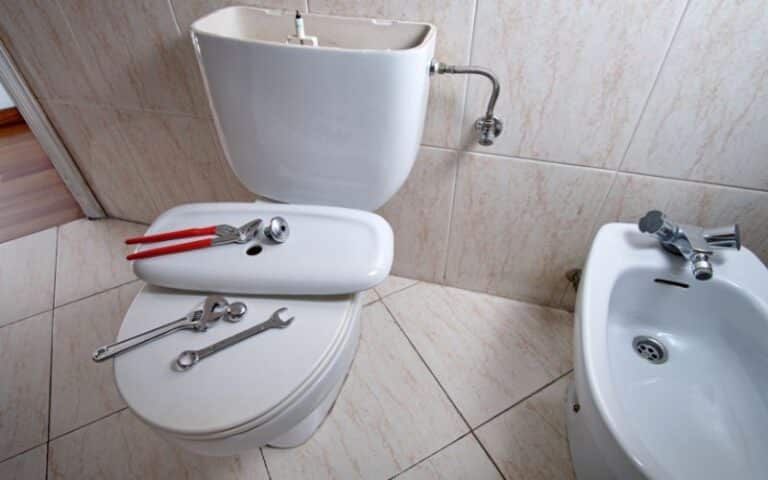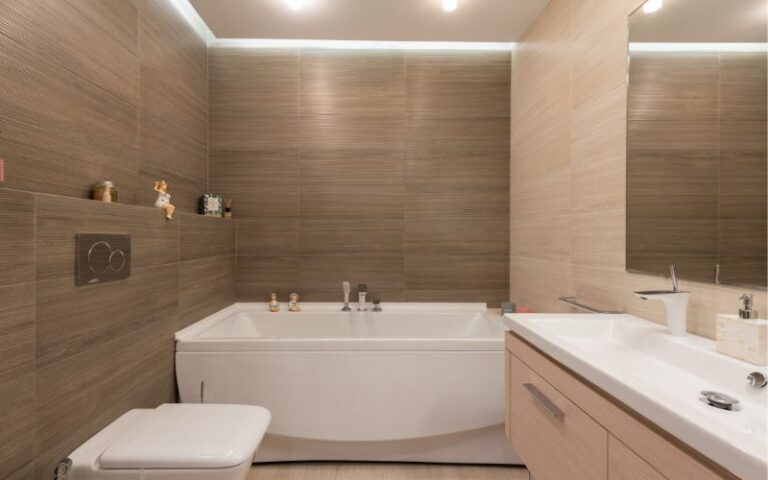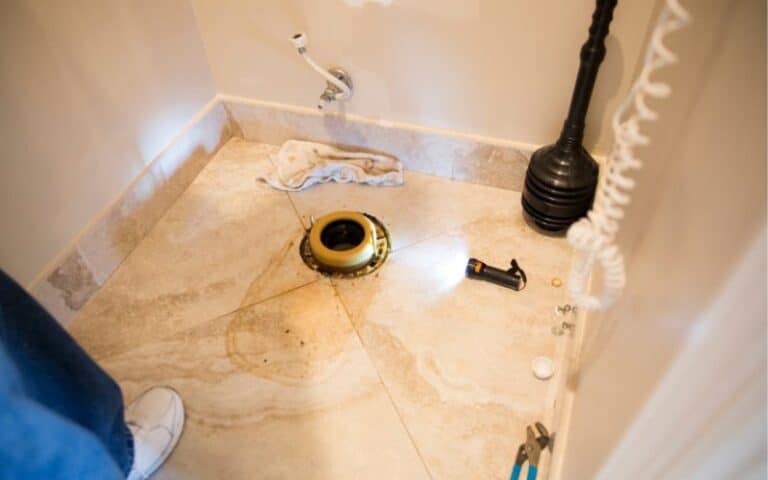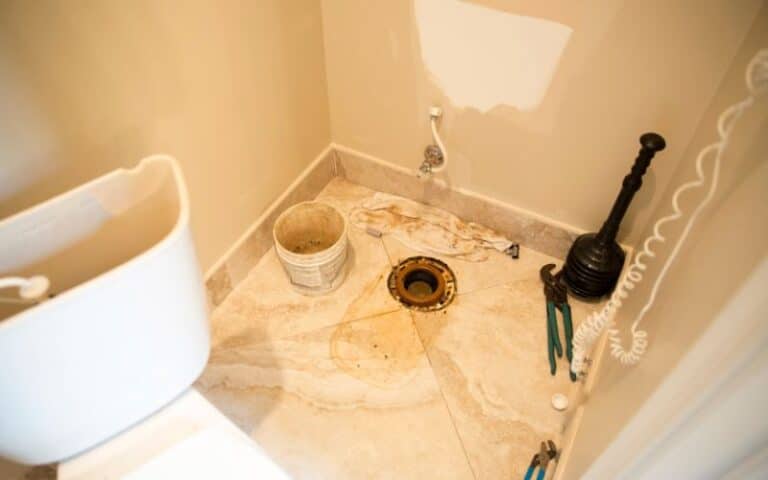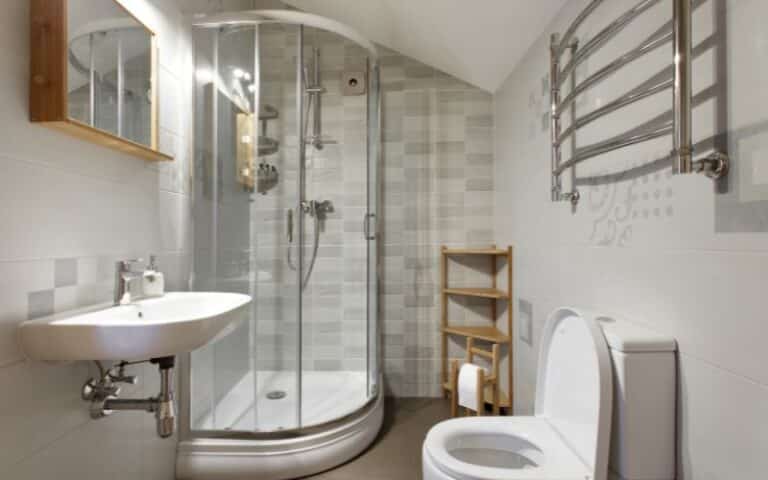Medium Density Fiberboard has been a staple in furniture and interior decoration.
It’s proving a worthy contender against other materials as demands for cost-effective solutions grow.
But its application in the bathroom might raise some eyebrows. These settings have high humidity and frequent water splashes.
Considering that it is not resistant to water, one might wonder: Is MDF truly suitable for such an environment?
Generally, MDF is unsuitable for use in bathrooms and other areas where humidity is a concern. However, one can use it under guided conditions for applications such as cabinets rather than baseboards. If you decide to use MDF in your bathroom, make sure it’s moisture-resistant and sealed or waterproof.
In this article, you’ll learn how to waterproof MDF to make it last longer. You’ll also discover alternatives for MDF.
Can You Use MDF in Bathrooms?
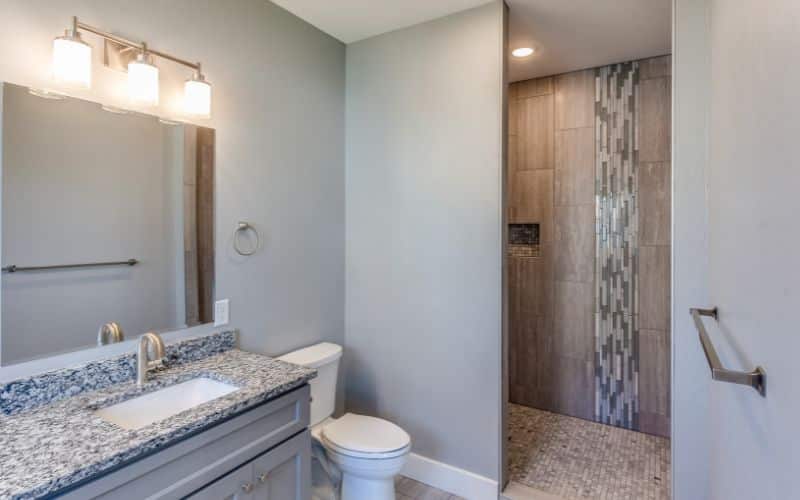
Yes, you can use MDF in bathrooms. However, you should consider some factors when considering its use in bathrooms.
Typically, bathrooms have high humidity levels, frequent temperature changes, and water spills. MDF is susceptible to water damage because of its porosity.
When exposed to moisture, MDF can swell, warp, and become structurally weak. Over time, exposure to moisture can lead to mold growth, which poses some risks and is difficult to remove.
To combat these issues, it’s critical to seal the MDF you intend to use in the bathroom. A good sealant or paint can create a barrier, preventing moisture from penetrating the MDF.
Also, in areas of direct water exposure, such as close to a shower, it is advisable to avoid MDF altogether.
Opt for more water-resistant materials such as PVC or solid wood for bathroom use.
You can use MDF for other bathroom applications, such as wardrobes and cabinets. It’s just not suitable for baseboards or bathtubs.
Vented bathrooms with good airflow help in reducing the risk of moisture-related damage.
However, even with these precautions, MDF in bathrooms requires regular inspection.
Furthermore, moisture-resistant MDF (MR-MDF) boards are available in the market. These MDF variants are suitable for damp environments.
MR-MDFs undergo special treatment to enhance their resistance to moisture. Opt for these moisture-resistant types if you’re considering MDF for bathroom applications.
While it’s possible to use MDF in bathrooms, it demands caution. Proper sealing, regular maintenance, and moisture-resistant MDF are essential to ensure durability.
How Do You Waterproof MDFs in Bathrooms?
Waterproofing them is necessary to maintain the integrity of MDF installation in bathrooms. Here is a step-by-step guide on how to do so:
#1. Clean the Surface
A clean surface aids in better adherence to waterproofing agents. So, before you start, ensure the MDF surface is completely dry, clean, and dust-free.
Use a damp cloth to wipe off debris and allow the surface to dry.
#2. Sanding
Use fine-grit sandpaper (around 220 grit) to sand the MDF’s surface lightly. This step ensures better adhesion of the sealant.
Once sanded, wipe away any dust with a clean, dry cloth.
#3. Seal the Edges
MDF edges are particularly porous and more susceptible to moisture. Hence, they require special attention.
Seal them with a clear or matching sealant. Apply multiple coats, allowing each to dry thoroughly before applying the next.
#4. Priming
Apply a good-quality oil-based primer to the MDF. The primer acts as a barrier and prevents the absorption of moisture.
Apply a brush or roller in even strokes, ensuring complete coverage. Let the primer dry completely as per the manufacturer’s recommendations.
#5. Apply Waterproof Paint and Sealant
Once the primer is dry, apply waterproof paint. Oil-based paints are more suitable as they form a better water-resistant layer.
Apply at least two coats, allowing the first coat to dry before applying the next. Always refer to the paint manufacturer’s guidelines for drying times.
After the paint has dried, apply a waterproof sealant over the MDF. It provides an additional layer of protection.
Various sealants, such as polyurethane, offer a clear finish. Apply the sealant using a brush or roller, covering the entire surface, and allow it to dry.
Even after waterproofing, check the MDF for signs of water damage regularly.
If you spot any, address them immediately. Avoid letting water stay on the surface for an extended period.
Do MDFs Attract Mold in Bathrooms?
In bathrooms, where moisture levels are typically high, MDF can cause concerns regarding mold growth.
The reason is MDF is more susceptible to water damage than solid wood.
When MDF gets wet, it swells and loses its structural integrity. This swelling creates pockets where water can become trapped.
If the moisture remains in these pockets without drying out, it provides an ideal mold environment. Mold thrives in warm, damp conditions, which unventilated bathrooms offer.
Using MDF in areas where it comes in contact with water, such as near bathtubs, is particularly risky.
Over time, splashes can lead to moisture penetration, increasing the potential for mold.
Furthermore, any damage to the protective finish of the MDF, such as paint or laminate, can expose the material to moisture.
Once the MDF absorbs this moisture, mold can start to grow.
To mitigate the risk of mold growth, ensure that the MDF used in bathrooms is properly sealed.
However, this barrier can deteriorate over time, so regular maintenance is necessary.
Also, ensuring good bathroom ventilation to reduce moisture levels is important. Using exhaust fans and opening windows can help prevent mold growth.
Furthermore, consider mold-resistant products on MDF surfaces if mold is recurring. Clean these surfaces regularly using mold cleaner or a mild detergent.
If you detect mold, immediately clean small areas with specialized mold removers. For extensive areas, you may need professional intervention.
Will a Moisture-Resistant MDF Swell in a Bathroom?
Moisture-resistant MDF can withstand a certain amount of humidity and contact with water. The resin makes it less absorbent to water, thus enhancing its durability in moist conditions.
However, “moisture-resistant” does not mean “waterproof.” Continuous exposure to water can cause MR MDF to swell or degrade over time.
Bathrooms, in particular, can have variable moisture levels, from showers to occasional splashes. If you use MR MDF in bathroom areas with water, there is a risk of it swelling.
This situation is especially true if you didn’t seal the edges of the MR MDF properly. In that condition, they are more porous and susceptible to water infiltration.
To optimize the lifespan of MR MDF in a bathroom setting, it’s crucial to ensure adequate ventilation.
Also, sealing the edges and surfaces can protect the material from moisture.
Check the MR MDF in your bathroom regularly for any signs of water damage. Quick repairs in the event of moisture-related issues can also help to extend the life of MR MDF in a bathroom.
What Is the Best Material to Use in a Bathroom?
Bathrooms demand materials that withstand moisture, heat, and daily wear and tear. The best material for this area depends on some considerations.
Here’s a comparison of the common materials used in the bathrooms to help one make a choice:
#1. MDF
MDF is popular for its smooth finish and workability. However, its suitability as a bathroom material is questionable.
It’s prone to water damage and swelling if not properly sealed. Over time, this condition can compromise its integrity in a moist environment like a bathroom.
The table below contains the advantages and disadvantages of MDF as a bathroom material:
| Advantages | Disadvantages |
|---|---|
| Cost-effective | Susceptible to water damage |
| Smooth and consistent surface | Can swell and warp if exposed to moisture |
| Easy to paint and customize | Shorter lifespan compared to solid wood or PVC |
| Versatile for various design applications | Requires sealing and maintenance to resist humidity |
#2. Plywood
Plywood is a more resilient choice for bathrooms compared to MDF. Its layered construction makes it more resistant to moisture and warping.
However, sealing and finishing are crucial to ensure its longevity.
Below are the advantages and disadvantages of using plywood as bathroom material:
#1. Advantages
- Higher moisture resistance than MDF
- Durable and strong
- Can be painted or stained
- Available in various grades for different needs
#2. Disadvantages
- More expensive than MDF
- Edges can delaminate if not sealed properly
- Susceptible to water damage if not treated
- Appearance might not be as smooth as MDF
#3. PVC
PVC is highly suitable for bathrooms due to its water-resistant and non-porous properties. As a synthetic material, it can withstand moisture and damp conditions.
It is ideal for bathroom installations where water is frequent.
Here are the pros and cons of using PVC in bathrooms:
#1. Pros
- Water and moisture-resistant
- Low maintenance
- Resistant to mold and mildew
- Lightweight and easy to install
#2. Cons
- Less environmentally friendly than wooden options
- Can look less natural or aesthetically pleasing
- Sensitive to high temperature and can warp
- Durability varies with quality; cheaper versions may be less robust
In conclusion, go for marine-grade plywood if you want to balance a natural look and water resistance.
PVC is your best bet if you prioritize water resistance and low maintenance.
You can use MDF in bathrooms, too. However, avoid it in areas of direct water exposure.

